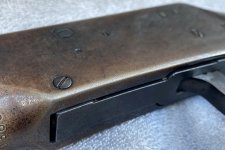Sounds like even those post 64 Winchesters are bringing some money lately. I bought one new in 1974 for just under $100. My fault for not being aware of the "changes" back then. Believe the receiver was from sintered steel process instead of being milled and would not take to a decent bluing. Still had a nice walnut stock even then. Swapped it for a Remington 700 a few years later with a few bucks thrown in.
Yes and no.
Yes, I'm seeing 1964-1981 (the post 1963 but still pre rebounding hammer and Angle Eject) Model 94 carbines in .30-30 sell for around $500 in just good to maybe very good condition, at least here in eastern NC. They are bringing that kind of money as they are one of the more affordable ways to get a Model 94 that still has the original quarter cock operating system with none of the later rebounding hammer, cross bolt or tang safeties.
On the other hand, I'm not lining up to buy one at that price any time soon. Why? Because I'm also seeing post WWII pre-64 Model 94 carbines in .30-30 sell for around $550-$600. The reason for that is two fold.
First, Winchester lever gun collectors are getting old and dying off faster than new collectors are becoming interested.
Second, the die hard collectors really regard WWII as the cut off point for collectible Winchesters. Winchester made a lot of M1s in WWII and essentially modernized and changed their production methods. Hard core collectors prefer the older hand fit Winchester lever guns.
Those two together mean the market for the post WWII, pre-64 Model 94 carbine in the most commonly chambered .30-30 is pretty soft right now.
And, as a shooter and soft core collector who believes every gun I own better be able to work for a living, I prefer the pre-64 Model 94 carbines and rifles as they are smoother and more accurate than the 1964-1981 Model 94s, and I despise the rebounding hammer on the mid 1981s and the 1982 and onward AEs. I also despise the cross bolt and tang safety Model 94s.
To quantify the accuracy difference, I have owned a total of four pre-64 20" Model 94 carbines in 30-30 and every one of them has been capable of 1.5 MOA 5 shot group accuracy at 100 yards with a tang sight and 150 gr Winchester soft point factory ammo, as well as my Hornady 150 gr soft point handloads. I still own three of them (although one is on long term loan to my FIL).
In contrast I have owned two of the newer Model 94s (a 1973 and a 1971) and both of them were 4 to 5 MOA accurate under the same circumstances. Not bad accuracy, and certainly minute of deer out to 150 yard (even 200 if the shooter is up to it), but not on the same level as the pre-64s.
----
That said, I'm also a fan of the XTR Model 94s which were made from 1978 through 1988. The fit is better as well as the finish and they'll generally shoot 2 MOA 5 shot groups at 100 yards.
I have an early (1978) Big Bore 94 carbine in .375 Win as well as a 24" Model 94 rifle in .38-55 in the Legendary Frontiersman commemorative format (1979). Both are shoot solid 2 MOA 5 shot groups. All of the Big Bore 94s made in the 1978-88 time frame were XTRs as were the commemoratives made in that timeframe.
----
The major change in the Model 94 in 1964 was the switch to a sinter-forged receiver. The process used powdered metal that was mixed to create the alloy, and then sinter forged in the die under intense heat and pressure.
The resulting receivers are reported to be slightly more porous than traditional forged receivers, but they are plenty strong and there are no issues with them failing.
The advantage for Winchester was that the sinter forged receiver came out of the die close to final shape and dimensions and they needed a lot fewer machining steps to complete.
If Winchester had left it at that most people may not have noticed. However, people did notice things like roll pins and stamped lifters and recoiled in horror. Winchester walked back those changes by 1966. To be honest I've never personally seen a stamped lifter or roll pin in the wild. I suspect most of those 1964 made carbines have had those parts replaced over the years - probably in 1965-66.
The problem with bluing those receivers by conventional means is the high percentage of chromium used in the alloy. I suspect it was used for greater strength or some other sound engineering reason.



